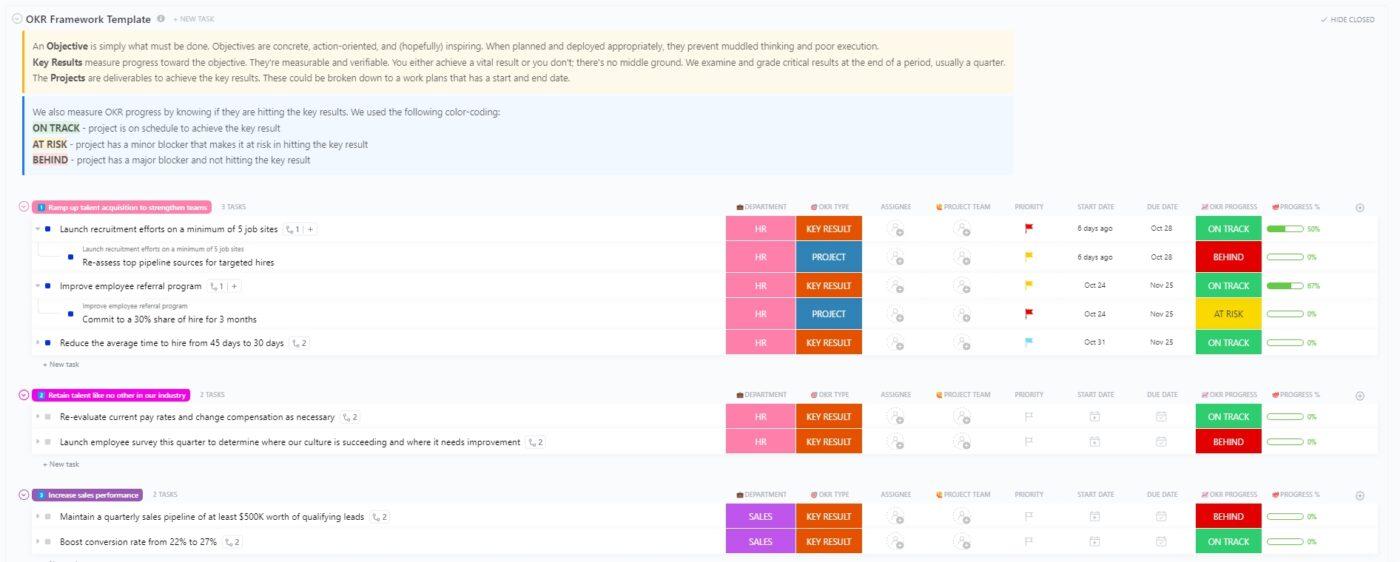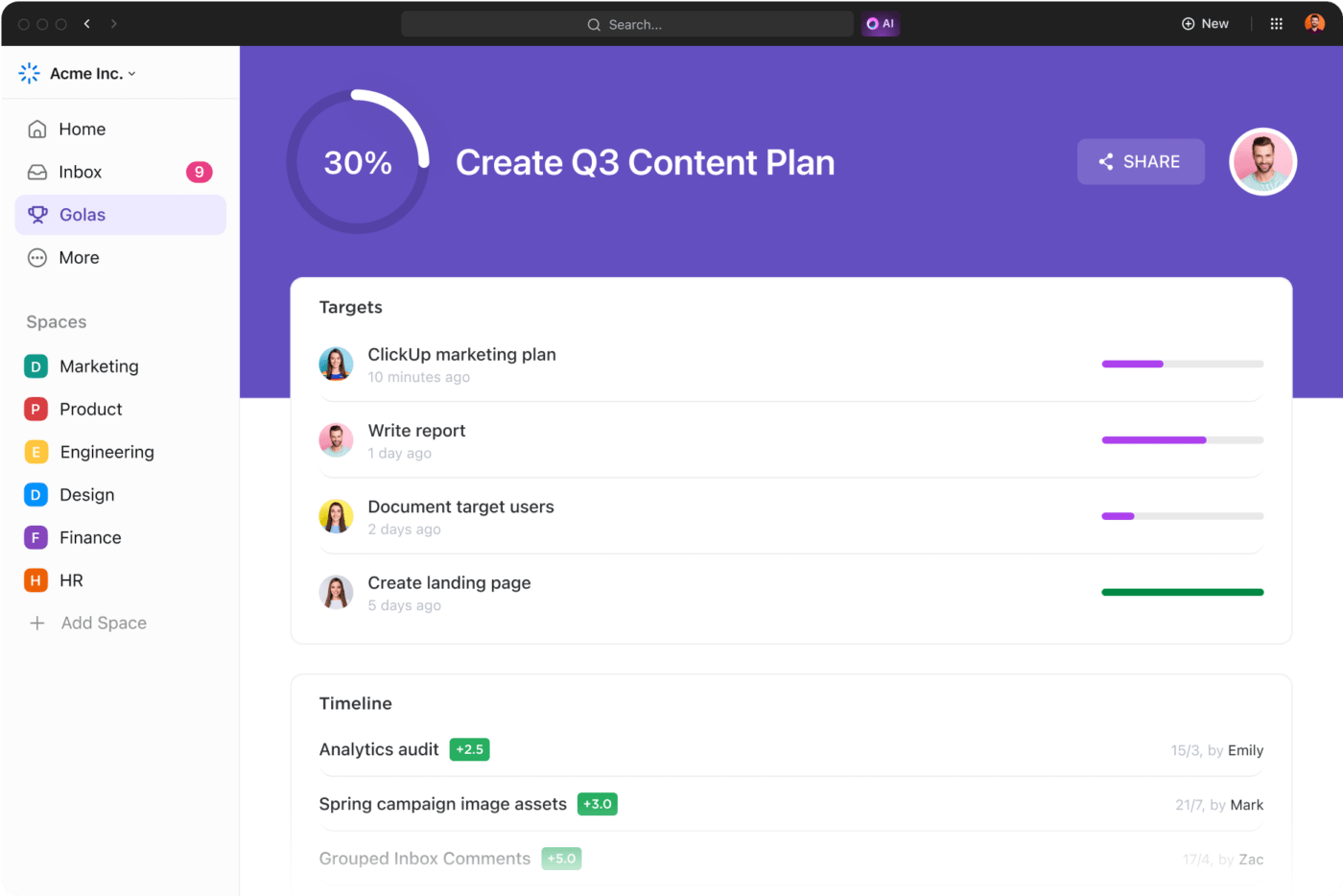Agile OKRs: Tools and Techniques to Maximize Efficiency

Sorry, there were no results found for “”
Sorry, there were no results found for “”
Sorry, there were no results found for “”
Agile objectives and key results (OKRs) are the backbone of a thriving Agile organization, providing support, structure, and flexibility.
OKRs offer a sturdy framework that supports the entire body of work, aligning and mobilizing teams toward common goals. Each OKR is a building block connecting team members’ efforts to the company’s larger strategic objectives.
According to a recent OKR Impact Report, 83% of companies found OKRs significantly enhanced their ability to communicate company goals, and 84% confirmed it improved team engagement. These are a testament to the transformative power of integrating OKRs into an Agile methodology for businesses.
This blog will guide you through the essentials of Agile OKRs, helping you harness their full potential to synchronize your team’s efforts, sharpen your focus, and accelerate your journey toward achieving key results.
Our insights and practical advice will transform an effective Agile OKR framework in your project management into a powerful tool.
Agile OKRs are a strategic framework teams and organizations use to set challenging, ambitious goals with measurable results. They bridge the gap between strategy and execution by converting broad objectives into specific, quantifiable business outcomes that everyone works toward.
For example, consider an Agile software development team. Their objective might be to ‘Enhance user experience to drive engagement.’ The key results to support this might include:
This clarifies what success looks like and provides tangible benchmarks to track progress and motivate the team towards continuous improvement, embodying the Agile principles of adaptability and focused delivery.
The Agile methodology is a known approach to project management that breaks the project into logical phases to help the team collaborate on tasks and improve results. Combining OKRs with Agile methodology creates a dynamic that significantly boosts business performance, agility, and team alignment.
Imagine an Agile software development team aiming to improve their product’s user experience (Objective). Their Key Results might include specific targets like reducing load time by 30% and increasing user retention by 25%.
Working in Agile sprints, they regularly review these key results, applying OKRs and Agile to adjust their strategies and actions based on real-time user feedback and performance data.
This approach keeps the team aligned with the company’s vision and ensures they continuously adapt and improve, embodying the core of business agility. Here’s how these concepts interplay:
Agile teams thrive on flexibility, continuous improvement, and customer satisfaction. OKRs complement these principles by providing a clear focus and measurable goals, ensuring every sprint and task aligns with the overarching business objectives.
This symbiosis fosters a responsive, agile organization that swiftly adapts to market conditions and customer needs.
At the heart of an Agile transformation, OKRs are leading indicators of success. By defining key results, teams have tangible benchmarks for tracking progress and measuring business outcomes.
This clarity helps the entire organization stay on the same page, driving towards desired business outcomes and ensuring that the Agile process contributes directly to business value.
According to studies, the three most common reasons for implementing OKRs are transparency, better prioritization, and more effective strategy execution. This leads to an overall successful Agile project management strategy.

For instance, ClickUp’s OKR framework slots into this approach by setting specific objectives at the team and company levels, helping to track progress and align teams around common goals.
Agile practices are about iterative development and constant learning. OKRs support this by facilitating endless feedback loops and enabling teams to measure progress against their objectives.
This setup encourages a culture of continuous improvement, where Agile teams regularly assess and adjust their approach to achieve better results.
Streamline implementing this synergy with the right tools. For instance, ClickUp’s OKR templates offer a structured way to set specific objectives at the team and company levels, helping to track progress and align teams around common goals.
‘Studies state that the most successful companies have a 28% higher communication intensity, measured by the number of communication channels used, and use OKR check-ins more often than the comparison group.’
Integrating Objectives and Key Results (OKRs) into Agile projects significantly enhances performance and business outcomes. Here are five key benefits:
OKRs help Agile teams prioritize their work by clearly defining what they need to achieve and how they will measure success. By setting specific, ambitious objectives and key results, Agile teams focus on the tasks that truly matter, ensuring that every sprint moves them closer to their strategic goals.
OKRs facilitate alignment across different levels of an organization. By connecting team objectives with the company’s vision, everyone understands how their work contributes to the bigger picture. This transparency ensures that all members work towards the same goals, enhancing collaboration and unity within Agile teams.
When team members are involved in setting their OKRs, they are more likely to be committed to achieving them. This sense of ownership increases accountability and significantly boosts engagement and motivation. As Agile teams meet and track their key results, they can see the direct impact of their work, further enhancing their commitment and satisfaction.
The Agile methodology emphasizes continuous improvement and adaptation. OKRs complement this by providing a framework for regular reflection and adjustment. Agile teams can review their progress toward key results at the end of each sprint, learn from their successes and failures, and make informed decisions about improvements going forward.
OKRs provide a clear set of Agile metrics to track progress and success. Key results are quantifiable and time-bound, making measuring performance easier for Agile teams. Agile teams complete the work and make tangible progress towards their objectives. Agile OKR software helps organizations, whether startups or MNCs, achieve better goal-setting and optimize performance.
Implementing OKRs (Objectives and Key Results) into Agile projects requires careful planning and consideration. Here’s a step-by-step guide to effectively integrate OKRs with Agile methodology.
Start by identifying what your team wants to achieve at a strategic level. Objectives should be inspiring, challenging, and aligned with the company’s vision and mission. Use the goals feature in the ClickUp tool to define and visualize these objectives. Besides, ClickUp’s Agile Templates make it easier for project managers to define objectives clearly.

For example, an objective could be ‘Increase market share by 20% in the next quarter.’ Assign this objective in ClickUp and make it visible to all relevant team members, ensuring everyone understands the direction and purpose. This fosters a unified focus and drives the organization towards common strategic goals.
Once you set objectives, define two or three measurable key results for each. Key results should be quantifiable and time-bound indicators of success.
This allows Agile teams to monitor their progress in real-time, ensuring that every action taken moves the needle on these critical success criteria.

For instance, if the objective is to increase market share, key results could be to ‘Achieve $1M in new sales’ and ‘Expand into two new regional markets.’ Utilize ClickUp’s Measurable Goals feature to track these metrics and set measurable goals.
Align your OKRs with Agile sprints effectively using ClickUp’s Agile release planning features, which include Time Estimates and Sprints, to ensure you design each sprint purposefully to progress towards your strategic goals.

For example, if a key result is to develop a new feature, plan a series of sprints focusing on design, development, and testing, setting time estimates for each phase.
This ensures that every sprint is purposefully designed to progress towards your strategic goals, maintaining a steady pace and clear direction.
Regular tracking is vital to understand the impact of your efforts. By regularly reviewing these reports, Agile teams will celebrate successes, identify areas for improvement, and make data-driven decisions. ClickUp’s reporting feature allows you to create custom reports to monitor progress against each key result.
For example, if you’re tracking new customer acquisitions, set up a weekly report showing the number of new sign-ups. This provides transparency and accountability and allows for continuous feedback and adjustment. Clickup’s Project Forecasting tools will enhance how you create custom reports and monitor progress against each key result, offering a predictive look at your project’s trajectory.

Agile is all about continuous improvement. As you track your progress in ClickUp, take the time to reflect on what’s working and what isn’t. If market conditions change or certain strategies do not yield the desired results, use ClickUp’s flexible platform to adjust your objectives and key results accordingly.
For instance, if a new competitor emerges, you might need to pivot your strategy and set new key results. Encourage regular retrospectives and updates within ClickUp to ensure your OKRs remain relevant and aligned with the company’s evolving needs and goals.
In each of the following OKR examples, the OKRs provide a goal-setting framework that helps Agile teams at various organizational levels apply principles of Agile and OKRs to achieve alignment, focus, and measurable success.
They contribute to a clear understanding of the company’s mission and strategic direction, ensuring all efforts are coordinated and contributing to the desired impact.
Explanation: This OKR focuses on product quality to increase customer satisfaction. It aligns Agile teams around the strategic goal of delivering a superior product, directly contributing to the organization’s mission of customer excellence.
Regularly measuring the reported bugs and customer satisfaction scores provides clear, measurable goals that help the team stay focused and understand their impact on the company’s vision.
Explanation: The objective here aligns with the strategic goals of expanding market presence. By specifying the desired outcomes of increased market share and the actionable steps of launching marketing campaigns, this OKR helps Agile teams align their efforts with the company’s growth objectives.
It clearly explains success and how each team member’s contributions move the needle.
Explanation: This OKR aims to enhance the organizational culture, often considered a lagging indicator of business health, but with ClickUp’s Goal-Setting software, it becomes a tangible, measurable target. Focusing on employee engagement and recognition seeks to create an environment where team members feel valued and motivated.

This objective directly contributes to the organization’s goals of retaining top talent and maintaining a productive workforce, ensuring everyone is on the same page and working towards the same goal.
Explanation: This OKR focuses on refining Agile methodology at the team level to achieve better efficiency and faster delivery.
The measurable goal setting encourages continuous improvement and provides a clear framework for tracking progress. This approach improves the Agile process and aligns with the broader company OKRs of delivering value quickly and effectively.
As businesses continue to evolve, so will the methodologies they employ. The future of Agile OKRs lies in increasingly personalized and intelligent systems. We can anticipate more predictive methods with advancements in AI and machine learning. Let’s take a brief look at the future trends:
Agile OKRs are vital in bridging the gap between ambitious goals and tangible business outcomes. They streamline the strategic planning process and infuse agility and precision into every aspect of project management. By effectively using OKRs, Agile teams will enhance focus, boost alignment, and drive remarkable business outcomes, all while staying adaptable to the ever-changing business landscape.
ClickUp’s Agile features, like OKR templates, Agile release planning, and project forecasting, provide an ideal platform for implementing these practices. It equips Agile project managers and teams with the tools necessary to set, track, and achieve their objectives in a structured yet flexible manner.
Whether you want to refine your Agile practices or start anew with OKRs, ClickUp offers a one-stop solution to transform your project management approach. Embrace the power of Agile OKRs and propel your team toward efficiency, alignment, and success.
Remember, the journey toward mastering Agile OKRs is continuous. With the right approach and tools, your team will achieve remarkable strides in productivity and satisfaction, resonating with your organization’s mission and long-term aims.
© 2025 ClickUp